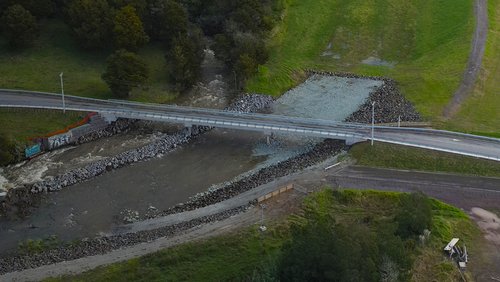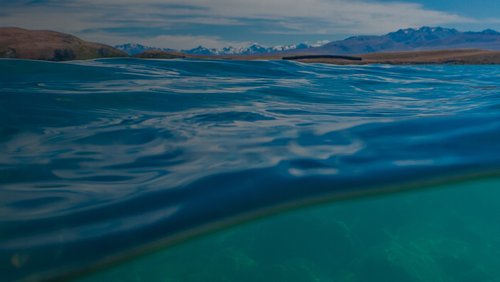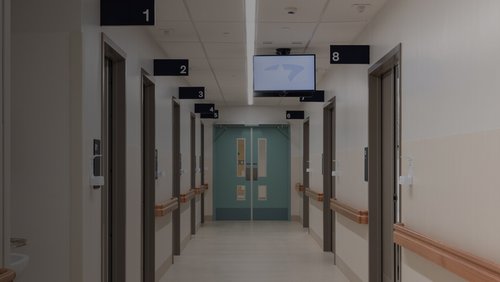19 Sep 2024
Wellington is feeling the pinch, hit by public sector job cuts and the temporary closure of some civic buildings for earthquake-strengthening work. But the city has not stalled. In fact, it’s currently undergoing a major transport-related overhaul, with several significant projects underway or recently completed.
KiwiRail National Train Control Hub
On an afternoon in March 2023, the team overseeing train movements around most of Aotearoa quietly handed over to colleagues sitting in front of a sea of monitors in a building 30-odd kilometres away. From seismically vulnerable Wellington Railway Station, national rail traffic control was re-routed in an instant to a purpose-built new centre in an Upper Hutt business campus.
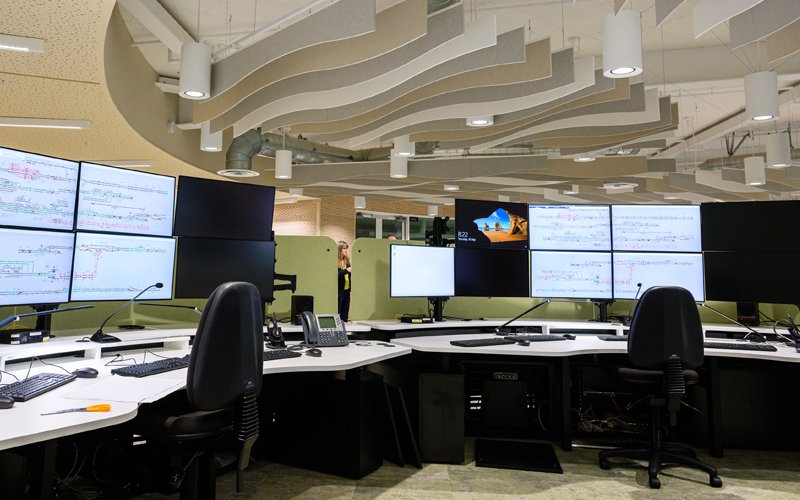
User workstations in KiwiRail's control centre. Photo: KiwiRail
“We went live very easily and very smoothly,” says KiwiRail Control Systems Integration Project Director Carl Mills. He led the project in Wellington as well as a second, more recently completed operation to build a new control centre in Ellerslie to oversee Auckland’s commuter rail network.
The spur for the change was the 2016 Kaikōura earthquake. By virtue of its new location, KiwiRail’s critical national nerve centre will now be less at risk from the tsunamis, slips, liquefaction and other hazards that could shut down train movements around the country. In addition, the 900-square-metre single-level structure has been designed to be highly resilient – and not only in terms of seismic performance. To safeguard power, data and communications continuity in a disaster, all workstations have been set up so that, at worst, the centre would only lose half of them and never an entire function. Also, data routes have been effectively “twinned”, with multiple fibre pathways into the building using separate ducts.
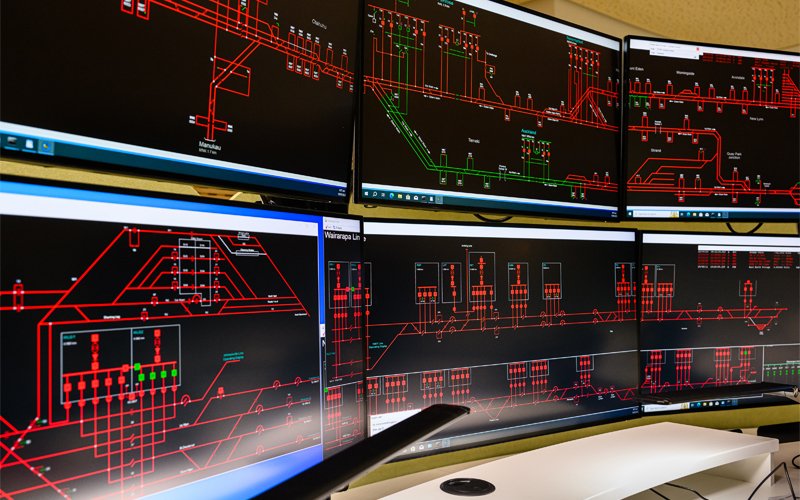
Control system schematic for overhead power supply. Photo: KiwiRail
The other standout feature of the project is the acoustic engineering. Noise is the enemy in a rail control centre, where a distraction or misheard communication over radio could prove disastrous. Previously, acoustic separation was achieved by putting everyone in separate offices, behind closed doors. The new centre achieves the same level of quiet through a combination of headsets and room acoustics – sound-absorbing timber ceilings, soft acoustic panels wrapped around workstations, and acoustic “clouds”.
“It is like a TV recording studio,” says Carl, adding that the new open-plan workplace is proving more collaborative, effective and enjoyable.
Te Wai Takamori o Awa Kairangi
Like a house built facing away from the view, Lower Hutt turns its back on its most appealing natural asset, the river. Among multiple objectives, Te Wai Takamori o Te Awa Kairangi programme is partly about correcting that historical misstep by creating improved walking and cycling links to and over the river, and the addition of new riverside development sites.
There’s more. The five-year programme of works will step up protection for Aotearoa’s most densely populated flood plain – Lower Hutt has a population of 110,000 and rising – and tackle unsafe traffic congestion around the Melling/State Highway 2 intersection, while forging better public transport links.
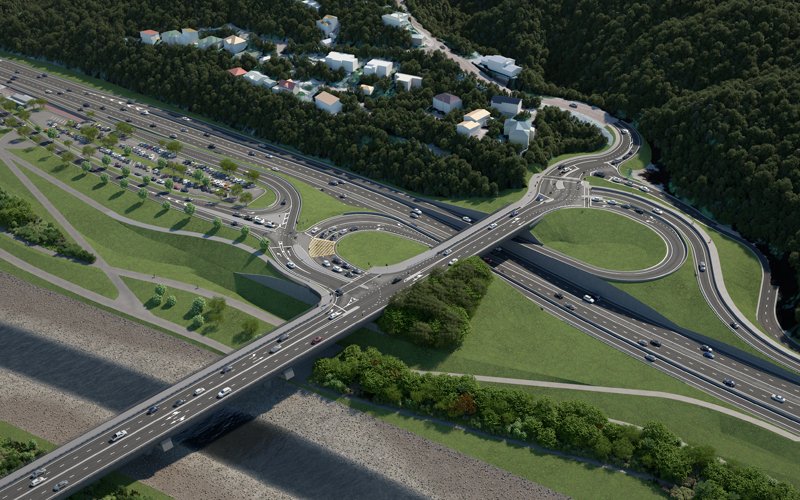
Revised design for SH2 Melling Interchange, part of Te Wai Takamori o Awa Kairangi.
It’s an ambitious programme, gifted a suitably consequential name. Te Wai Takamori o Te Awa Kairangi means “The Soothing Waters of Te Awa Kairangi” and refers to the story of how the ancient tupua Ngake created the river as he strived to escape a land-locked lake.
The five partners involved include iwi Taranaki Whānui ki Te Upoko o Te Ika and Ngāti Toa Rangatira, Greater Wellington, Hutt City Council and NZ Transport Agency Waka Kotahi (NZTA). Through an alliance with AECOM and Fletcher Construction, NZTA will deliver the Melling transport improvements (including a new grade-separated SH2 Melling interchange and bridge over Te Awa Kairangi/Hutt River, relocation of the Melling train station and improved walking and cycling paths). The Alliance team is also working with Hutt City Council to deliver the City LInk Bridge that links the railway station with the city centre. Outside the Alliance, Greater Wellington will handle river works and stopbanks while Hutt City Council will tackle improvements to local roads and streetscapes.
Given the devastation caused by storm events around Aotearoa in the past few years, and with more extreme weather events, arguably the programme's most pressing order of business is flood protection. Graeme Campbell, Greater Wellington’s Strategic Advisor for Flood Resilience, says the goal is to upgrade Lower Hutt’s stopbank system to withstand a one-in-440-year flood event, which has a 0.23 percent chance in any year. This includes an allowance for climate change. To achieve it, the existing Melling Link Bridge, which forms a chokepoint in the river, will go, and the stopbanks will be raised and widened. Providing a bigger stopbank while giving the river as much room as possible and removing existing services is part of the challenge.
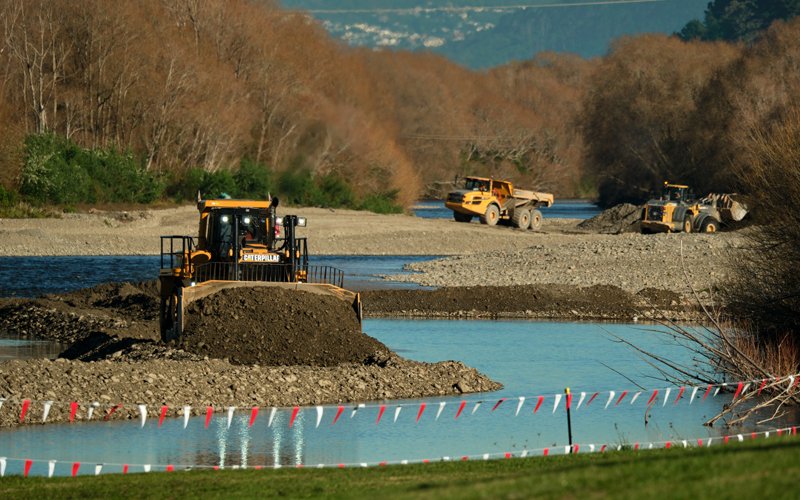
Construction of the Mills St stopbank is progressing well. Photo: Greater Wellington
Transport? Currently, the Melling interchange is congested and unsafe. Transport improvements here will remove the dangerous right-hand turns to and from the state highway by building a grade-separated interchange. But fitting a solution between the river and the western hills is challenging. The grade-separated interchange will operate more safely and efficiently. Meanwhile, the Melling train station will be relocated and linked to an all-new pedestrian and cycle bridge. This programme of works will help turn Lower Hutt into a better-connected city, with better access to the state highway, public transport, walking and cycling, and a healthier river.
Te Ara Tupua
According to the traditional Māori creation story, the battle between the tupua Whātaitai and Ngake was earth-shattering, but it gave us Te Whanganui-a-Tara/Wellington Harbour. Now a $311.9m project named in reference to those two tupua is under construction. A key goal: to give the harbour’s western edge the resilience it will need to withstand whatever climate change and seismic upheaval can throw at it.
Te Ara Tupua, gifted by Kura Moeahu, one of the mana whenua leaders, is about more than resilience. When completed in 2026, it will also provide cyclists and walkers with a safe coastal pathway between Wellington and Lower Hutt, complete with six ūranga (landings) to take in the view.

Rock and XblocPlus units are stored on the Te Ara Tupua project site before being transported to work areas. Photo: NZTA
“Not only will it make it safer, but it will open up demand,” says Project Director Ulvi Salayev FEngNZ CPEng, citing official forecasts of 2,100 cycle trips per day, 360 walking or running, and 290 on e-scooters and similar.
The same five partners on Te Awa Kairangi are involved here, along with Wellington City Council, and the project has been divided into two sections. The first is a five-metre-wide, 4.5-kilometre shared path between the Ngā Ūranga interchange and Pito-One. It includes boulder and concrete revetments (plus six seawalls in places with high value habitats) designed to protect the pathway and neighbouring rail line and highway from erosion by waves, as well as a rail overbridge at the Ngā Ūranga end. It’s being delivered by alliance partners Tonkin + Taylor, Downer and HEB Construction, and is well underway, with a targeted completion of 2026. The second section, a 3.5km cycleway from Pito-One to Melling at Lower Hutt, was delivered by Fulton Hogan and opened in October.
We have flora and fauna there, we have KiwiRail next to us, so how do we balance all of that while moving fast to deliver the project on time and budget?
Ulvi highlights the critical nature of the corridor, which as well as a state highway and a rail line incorporates the pipes that provide up to 70 percent of Wellington’s water. In 2013, a storm washed out part of the seawall between Ngā Ūranga and Pito-One and disrupted rail services for a week. On that evidence, the decades-old revetments won’t withstand the impact of climate change. Their replacements will be composed of 144,000 tonnes of boulders, supplemented with precast concrete X-shaped blocks, each 2.6 tonnes, that interlock like Lego to provide armour against storms and wave-action. Both the revetments and sea walls have been designed so they can be raised to accommodate future sea level rise at reduced cost.
Constructing this section of Te Ara Tupua will be difficult. As Ulvi points out, they’re operating between a rail line and the water, cheek by jowl with a major faultline.
“We have flora and fauna there, we have KiwiRail next to us, so how do we balance all of that while moving fast to deliver the project on time and budget?”
The concrete blocks are part of the answer, being more cost-effective and quicker to deliver than boulders. Another cost- and labour-saving innovation on the project is the use of GPS-enabled “digital shield” technology to manage the movement of heavy machinery around the rail line. As for mitigating the impact on flora and fauna, two rocky habitats have been constructed 40m offshore to accommodate birds disrupted by the project, and 56 artificial reefs have been placed to provide habitat for seaweeds, algae, crayfish and shellfish.
Civil building updates
Stricter seismic standards have put some of Wellington’s key civic buildings temporarily out of action. How are things progressing?
Civic Administration Building
Demolition work was to begin in late June and conclude in December.
The Town Hall
As of June, seismic work was largely complete, and the focus had shifted to completing the new auditorium basement and reinstatement works.
Central Library
Strengthening and modernising Te Matapihi began in 2022, with a predicted completion in 2026. In 2023, new piles and base isolation were installed; earlier this year a “rattle zone” was created and a ground concrete slab poured.
This article was first published in the September 2024 issue of EG magazine.

